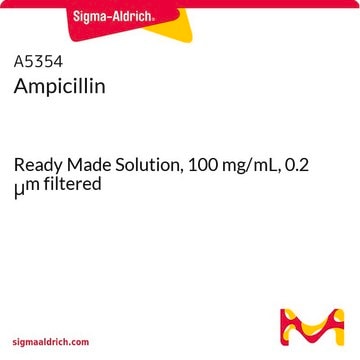If this product has an expiration or retest date, it will be shown on the Certificate of Analysis (COA, CofA). If there is no retest or expiration date listed on the product's COA, we do not have suitable stability data to determine a shelf life. For these products, the only date on the COA will be the release date; a retest, expiration, or use-by-date will not be displayed.
For all products, we recommend handling per defined conditions as printed in our product literature and website product descriptions. We recommend that products should be routinely inspected by customers to ensure they perform as expected.
For products without retest or expiration dates, our standard warranty of 1 year from the date of shipment is applicable.
For more information, please refer to the Product Dating Information document: https://www.sigmaaldrich.com/deepweb/assets/sigmaaldrich/marketing/global/documents/449/386/product-dating-information-mk.pdf
A9518
Ampicilline sodium salt
Synonyme(s) :
D-(−)-α-aminobenzylpénicilline sodium salt
About This Item
Produits recommandés
Source biologique
synthetic (chemical)
Niveau de qualité
Forme
powder
Couleur
white to off-white
Pf
215 °C (dec.) (lit.)
Solubilité
water: 50 g/L
Spectre d'activité de l'antibiotique
Gram-negative bacteria
Gram-positive bacteria
Application(s)
agriculture
Mode d’action
cell wall synthesis | interferes
Température de stockage
2-8°C
Chaîne SMILES
[Na+].CC1(C)SC2[C@H](NC(=O)[C@H](N)c3ccccc3)C(=O)N2[C@H]1C([O-])=O
InChI
1S/C16H19N3O4S.Na/c1-16(2)11(15(22)23)19-13(21)10(14(19)24-16)18-12(20)9(17)8-6-4-3-5-7-8;/h3-7,9-11,14H,17H2,1-2H3,(H,18,20)(H,22,23);/q;+1/p-1/t9-,10-,11+,14-;/m1./s1
Clé InChI
KLOHDWPABZXLGI-YWUHCJSESA-M
Vous recherchez des produits similaires ? Visite Guide de comparaison des produits
Description générale
Application
- pour sélectionner le phénotype de résistance à l'ampicilline dans les cellules transformées et comportant des mutations.
Actions biochimiques/physiologiques
Mode de résistance : les bêta-lactamases clivent le cycle bêta-lactame de l'ampicilline, la rendant inactive.
Spectre antimicrobien : agit sur les bactéries à Gram positif (activité comparable à la benzylpénicilline) et à Gram négatif (activité comparable aux tétracyclines et au chloramphénicol).
Caractéristiques et avantages
- Antibiotique de grande qualité convenant à de nombreuses applications de recherche.
- Idéal pour la recherche en biochimie et en biologie cellulaire.
Attention
Notes préparatoires
Stockage et stabilité
Autres remarques
Produit comparable
Produit(s) apparenté(s)
Mention d'avertissement
Danger
Mentions de danger
Conseils de prudence
Classification des risques
Resp. Sens. 1A - Skin Sens. 1A
Code de la classe de stockage
11 - Combustible Solids
Classe de danger pour l'eau (WGK)
WGK 3
Point d'éclair (°F)
Not applicable
Point d'éclair (°C)
Not applicable
Équipement de protection individuelle
dust mask type N95 (US), Eyeshields, Faceshields, Gloves
Faites votre choix parmi les versions les plus récentes :
Certificats d'analyse (COA)
Vous ne trouvez pas la bonne version ?
Si vous avez besoin d'une version particulière, vous pouvez rechercher un certificat spécifique par le numéro de lot.
Déjà en possession de ce produit ?
Retrouvez la documentation relative aux produits que vous avez récemment achetés dans la Bibliothèque de documents.
Les clients ont également consulté
Articles
Overview on how to maintain proper cell culture laboratory safety including steps on performing lab risk assessments, surface disinfection, biohazard and waste removal. Free ECACC handbook download.
-
How can I determine the shelf life / expiration / retest date of this product?
1 réponse-
Utile ?
-
-
How is shipping temperature determined? And how is it related to the product storage temperature?
1 réponse-
Products may be shipped at a different temperature than the recommended long-term storage temperature. If the product quality is sensitive to short-term exposure to conditions other than the recommended long-term storage, it will be shipped on wet or dry-ice. If the product quality is NOT affected by short-term exposure to conditions other than the recommended long-term storage, it will be shipped at ambient temperature. As shipping routes are configured for minimum transit times, shipping at ambient temperature helps control shipping costs for our customers. For more information, please refer to the Storage and Transport Conditions document: https://www.sigmaaldrich.com/deepweb/assets/sigmaaldrich/marketing/global/documents/316/622/storage-transport-conditions-mk.pdf
Utile ?
-
-
We purchased Ampicillin sodium salt (loc #BCBL4878V) back in 2014. This has been stored as a powder in the fridge since we purchased it. Is there an expiration for the powder?
1 réponse-
This product is assigned an expiration date of approximately of one year from the date of quality release. To assure optimum potency, it would be best to purchase new material.
Utile ?
-
-
What is the solubility of Product A9518, Ampicillin sodium salt?
1 réponse-
This product is soluble in water at a concentration of 50 mg/mL, producing a clear, colorless to faint yellow solution.
Utile ?
-
-
What is the Department of Transportation shipping information for this product?
1 réponse-
Transportation information can be found in Section 14 of the product's (M)SDS.To access the shipping information for this material, use the link on the product detail page for the product.
Utile ?
-
-
Is Ampicillin product stable in solution?
1 réponse-
We recommend using freshly prepared solutions. A concentrated solution of sodium ampicillin in water (approximately 330 mg/mL) may be expected to lose about 10% potency in 20 hours at -20°C.
Utile ?
-
-
How do I use Ampicllin in agar plates?
1 réponse-
For plates, add ampicillin to autoclaved media cooled to 48°C, to a final concentration of 35-50 μg/mL. Pour the plates, and allow them to cool completely. Plates may be stored at 2-8°C for up to only 1-2 weeks before use.
Utile ?
-
Filtres actifs
Notre équipe de scientifiques dispose d'une expérience dans tous les secteurs de la recherche, notamment en sciences de la vie, science des matériaux, synthèse chimique, chromatographie, analyse et dans de nombreux autres domaines..
Contacter notre Service technique








